Key takeaways:
- Equity in projects requires actively listening to diverse perspectives and engaging with communities to understand their unique needs.
- Conducting community assessments and establishing mentorship programs can significantly improve equity and foster professional growth.
- Identifying equity gaps involves analyzing demographic data and facilitating discussions to uncover barriers that marginalized communities face.
- Sharing success stories can inspire collective action and highlight the importance of equitable access in healthcare initiatives.
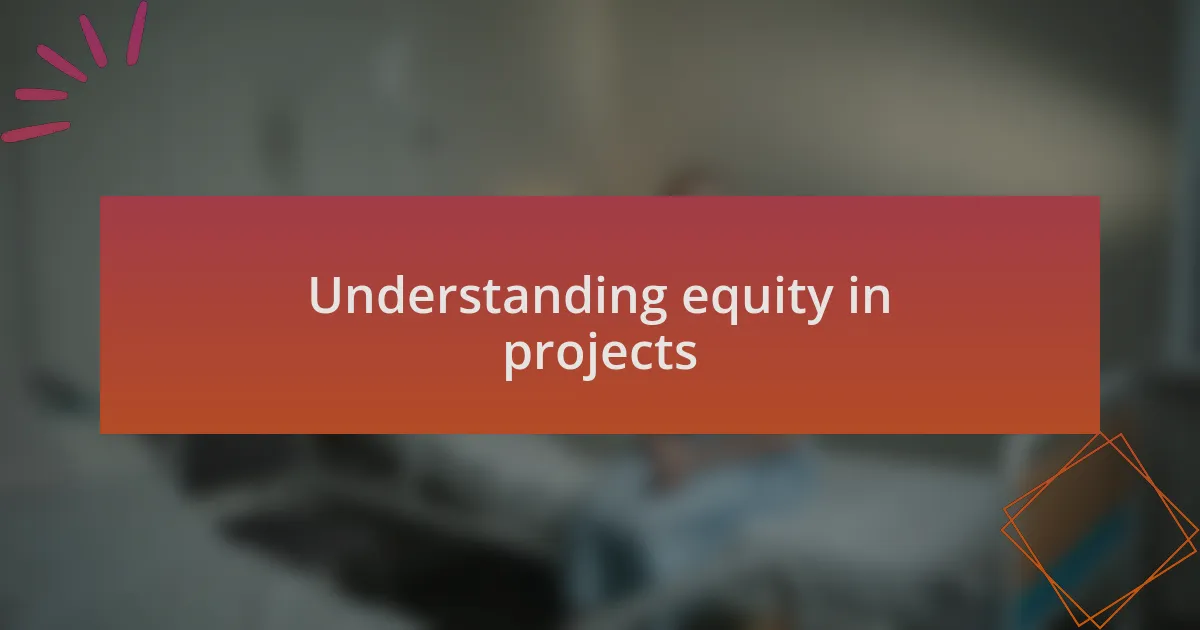
Understanding equity in projects
Equity in projects is all about ensuring that all participants have fair access to resources and opportunities. From my experience in surgical research, I’ve witnessed firsthand how small disparities can significantly impact outcomes. When evaluating a project’s equity, I often ask myself: Are we truly considering the unique needs of all stakeholders?
I recall a project focused on improving surgical techniques in underserved communities. It was enlightening to see how involving local practitioners not only enriched our findings but also fostered trust within the community. This taught me that equity is not just a buzzword; it’s essential for the credibility and effectiveness of any endeavor.
Understanding equity requires us to challenge our assumptions and actively listen to diverse perspectives. I encourage colleagues to engage with communities, asking: How do their experiences shape our project goals? By doing so, we create a more inclusive environment that drives innovation and meaningful change.
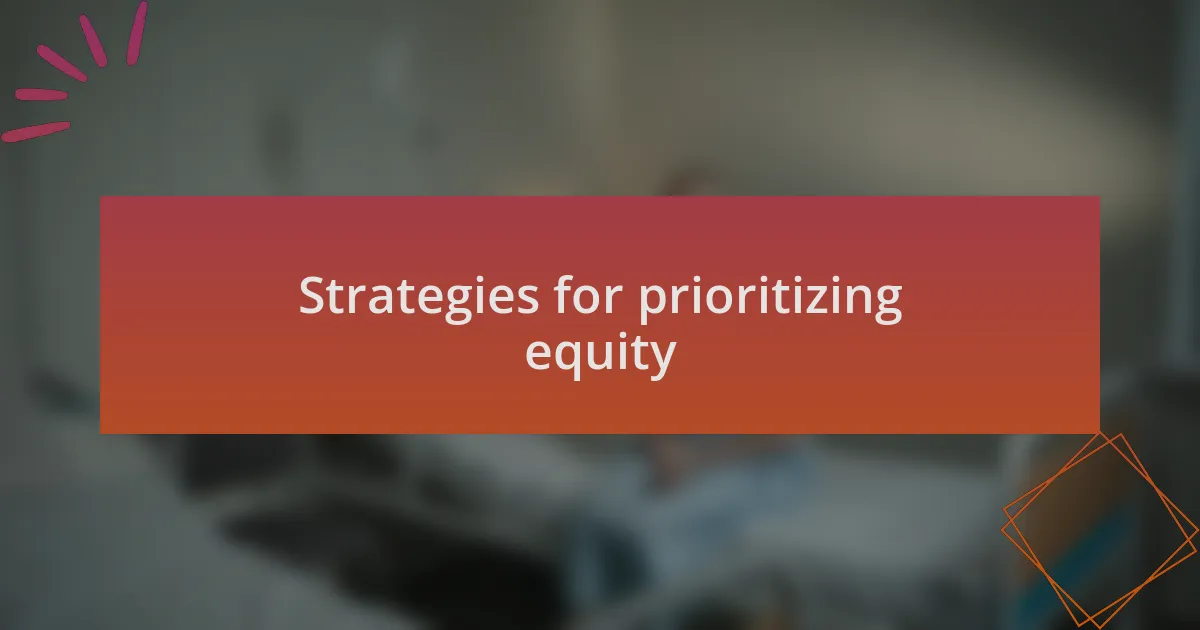
Strategies for prioritizing equity
One effective strategy I’ve adopted for prioritizing equity in projects is to conduct thorough community assessments. This involves actively reaching out to stakeholders before finalizing plans. I recall a surgical initiative where we organized focus groups in the community. The feedback was revealing—what we thought were the most pressing issues weren’t even on their radar. This experience really underscored the importance of listening to those directly affected.
In another instance, we implemented a mentorship program pairing experienced surgeons with trainees from underrepresented backgrounds. The impact was profound. Not only did this foster professional growth, but it also created a sense of belonging and empowerment among the trainees. It made me wonder: how often do we miss out on innovative solutions because we don’t intentionally seek diverse voices in our projects?
Furthermore, I have found that setting measurable equity goals keeps the focus sharp. By establishing specific benchmarks, teams can regularly assess their progress and hold each other accountable. For example, during a recent project, we tracked not only surgical outcomes but also how inclusive our recruitment processes were. This dual focus allowed us to refine our strategies continuously. It reminded me that equity isn’t just an endpoint; it’s an ongoing journey that requires dedication and adaptation.
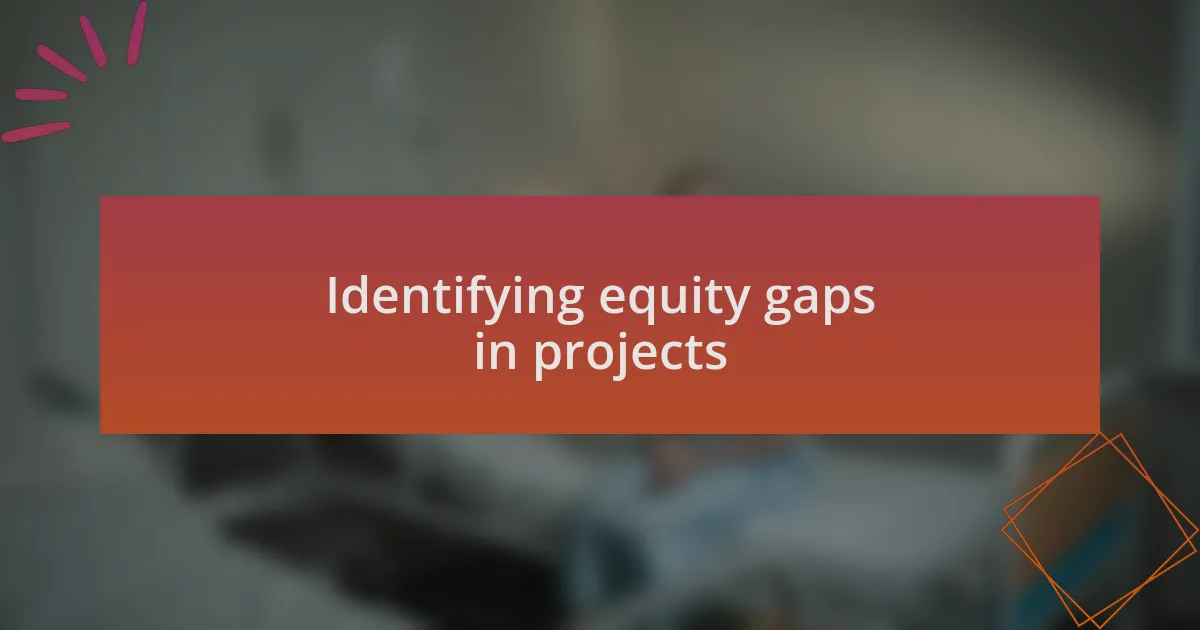
Identifying equity gaps in projects
Identifying equity gaps in projects begins with examining the demographic data of participants involved. I remember a project where I dove into the statistics and realized that certain communities were underrepresented in our study. It struck me how vital it is to analyze such data—not just to check a box, but to genuinely understand who we were leaving out. Are we inadvertently perpetuating disparities by overlooking these gaps?
In another situation, we facilitated a series of discussions with both patients and providers, questioning them about their experiences with healthcare access. It was eye-opening to hear stories of individuals who felt marginalized, despite their need for surgery being paramount. Their perspectives highlighted specific barriers we hadn’t considered, like transportation challenges or language barriers. This made me reflect on how often we assume we know the full story.
Lastly, I always encourage teams to conduct equity audits. In one audit, we assessed our project’s outreach methods and discovered that some flyers were only available in English. A simple oversight like this can have widespread implications on who receives vital information. It leads me to ask: how many potential participants remain unaware of resources simply because we failed to meet them where they are? By identifying these gaps, we can better align our projects with the diverse needs of the communities we serve.
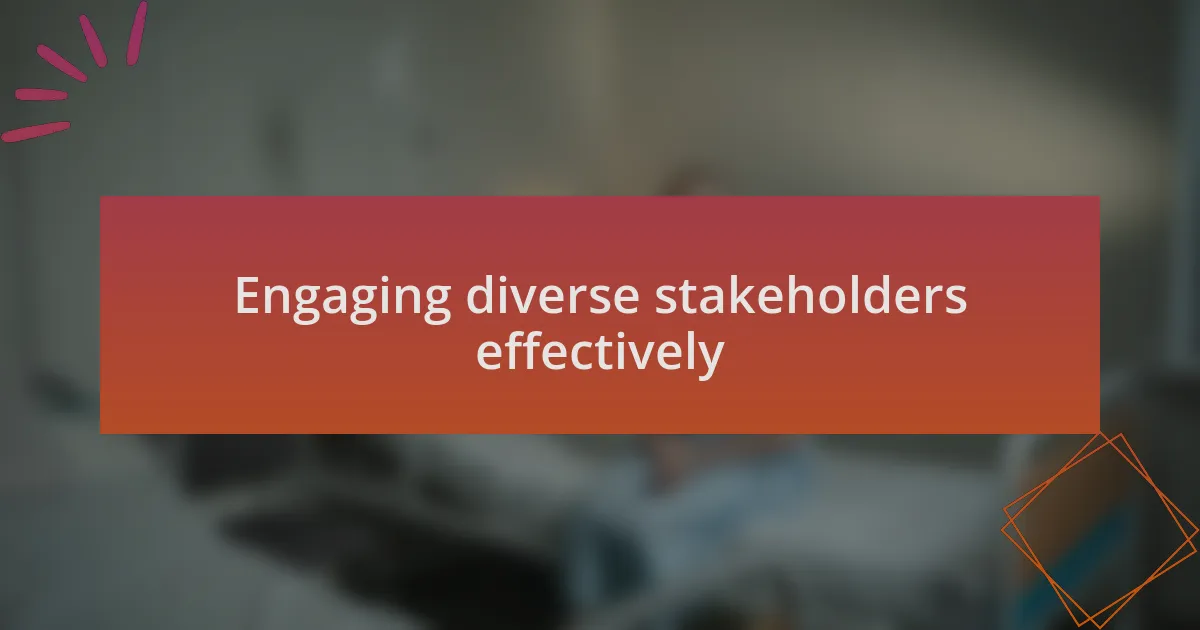
Engaging diverse stakeholders effectively
Engaging diverse stakeholders effectively requires a meaningful connection tailored to their unique perspectives. I recall a project where we invited community leaders to share their insights during an early brainstorming session. The value of their input was immeasurable, as they brought forth issues that hadn’t crossed our minds, highlighting the importance of co-creating solutions. How often do we miss out on pivotal insights simply because we don’t initiate those critical conversations?
Building trust is paramount when engaging with diverse stakeholders. I can remember meeting with a group of patients who initially felt skeptical about our intentions. Through open dialogue and active listening, we established a rapport that transformed our relationship. It’s fascinating to think how vulnerability can pave the way for collaboration—by acknowledging our shared goals, we created a space where everyone felt empowered to voice their thoughts.
Utilizing creative engagement strategies can also make a significant difference. In one project, we organized community forums where participants could express their concerns in a more relaxed environment. The informal setup encouraged storytelling, and I was moved by the personal narratives that emerged. It made me ponder: is our usual approach to stakeholder engagement stifling genuine dialogue? By thinking outside the box, we can create opportunities for richer, more impactful interactions that honor the diversity within our communities.
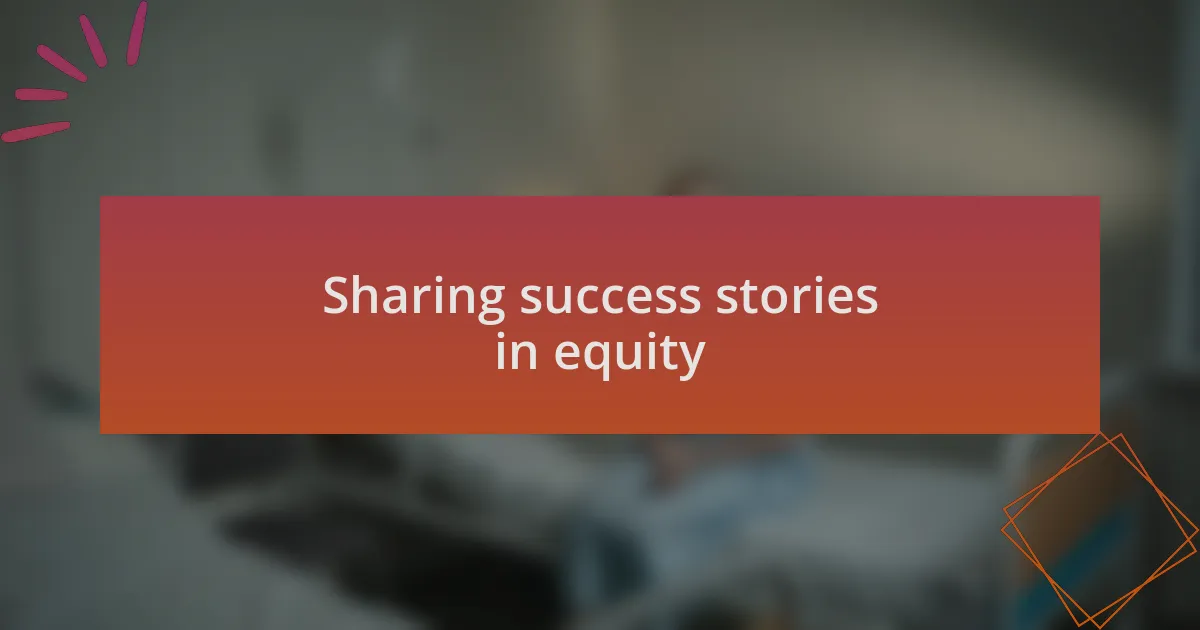
Sharing success stories in equity
Sharing success stories in equity is a powerful way to inspire collective action and motivate others. I remember a time when a community health initiative celebrated its success by spotlighting individuals who had benefited from equitable care access. Hearing their stories of resilience and transformation was incredibly moving; it was as if their journeys became a beacon for others in need. How could we not be driven to continue this important work when real lives are touched in such a profound manner?
One impactful success story was from a surgical project aimed at reducing disparities in care for underrepresented populations. After implementing tailored outreach strategies, we documented a notable increase in participation from communities that had historically been overlooked. It was a reminder that when we invest effort into understanding and addressing access barriers, we can achieve remarkable outcomes. I often wonder, wouldn’t sharing these stories widely not only validate our efforts but also foster an environment where equity is prioritized at the forefront of every project?
Additionally, I’ve learned that success stories do more than celebrate achievements; they create a sense of belonging for those who might feel marginalized. During a recent presentation, I shared a story about a young woman whose life changed through our initiative. The room fell silent as she recounted her experience, and I could see the emotion reflected in everyone’s faces. It’s moments like these that underscore the importance of storytelling in equity work—how can we harness these narratives to fuel change and inspire action in our communities?
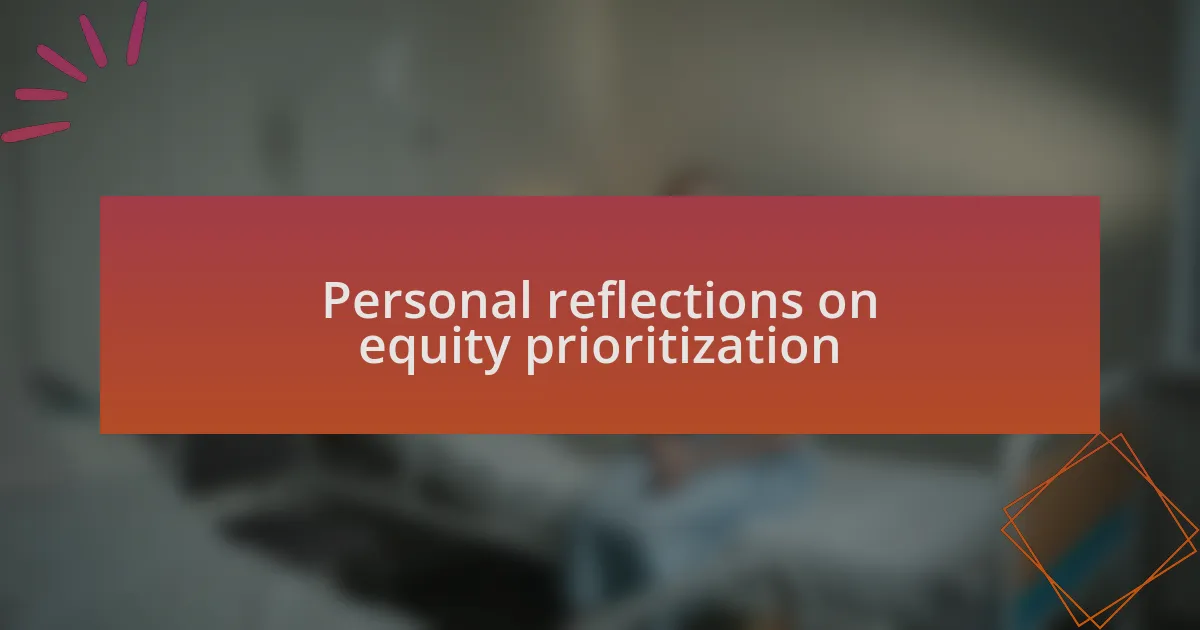
Personal reflections on equity prioritization
Throughout my journey in prioritizing equity, I’ve often found myself reflecting on the first project I led that focused on underserved patients. I remember sitting in a small community center, hearing firsthand about the challenges these individuals faced in accessing surgical care. It hit me hard—how could I not feel a sense of responsibility to change this narrative? Their voices became my motivation; it was a tangible reminder that equity isn’t just a concept—it’s a critical need.
One particularly enlightening moment occurred during a team debrief after a successful outreach event. As we reviewed the data, I noticed a significant uptick in appointments booked by a specific demographic. The team celebrated, but I found myself pondering—what does true equity look like if we’re still seeing disparities? That question hasn’t left me; it pushes me to continually ask how we can refine our approaches to ensure that every voice is heard and every story matters.
Engaging with diverse stakeholders has been pivotal in my understanding of equity prioritization. I vividly recall a roundtable discussion where a local leader shared her experience navigating the healthcare system for her elderly parents. Her frustration resonated with me, reflecting the systemic barriers that too many face. It made me realize—how often do we truly listen to those we aim to serve? This dialogue, rich with personal stories, is what shapes my perspective and fuels my commitment to advocate for equitable practices in every project I undertake.